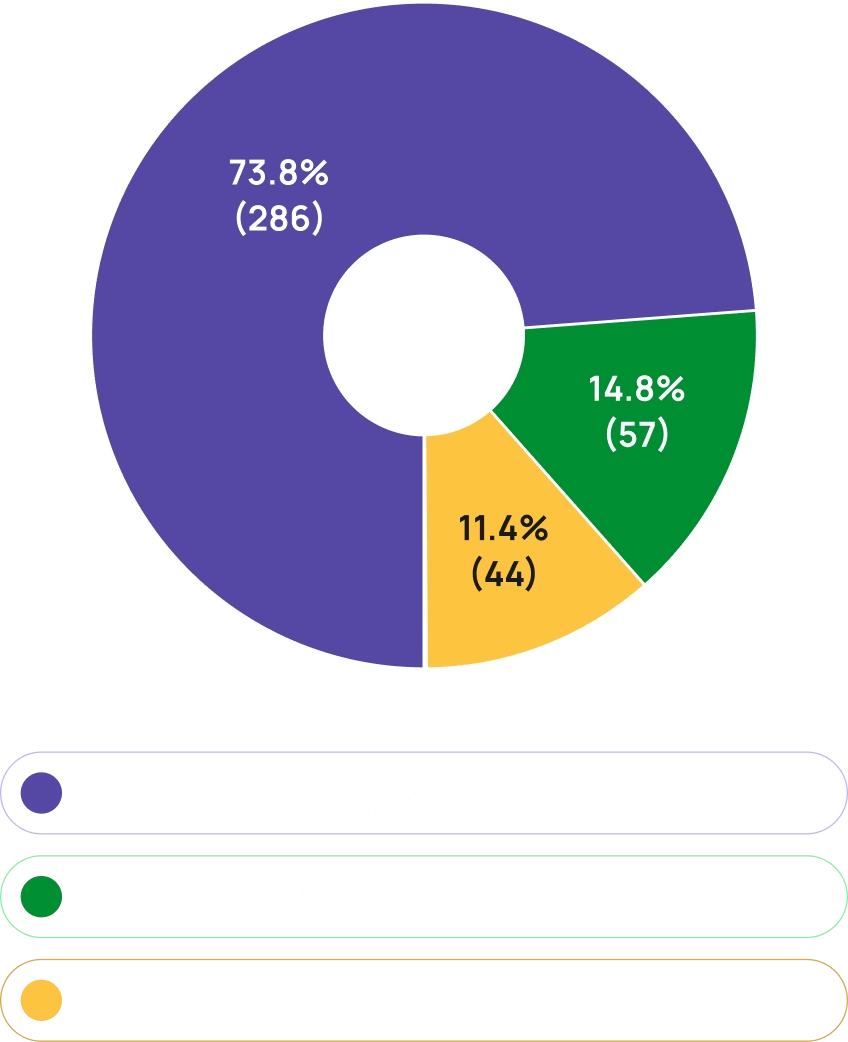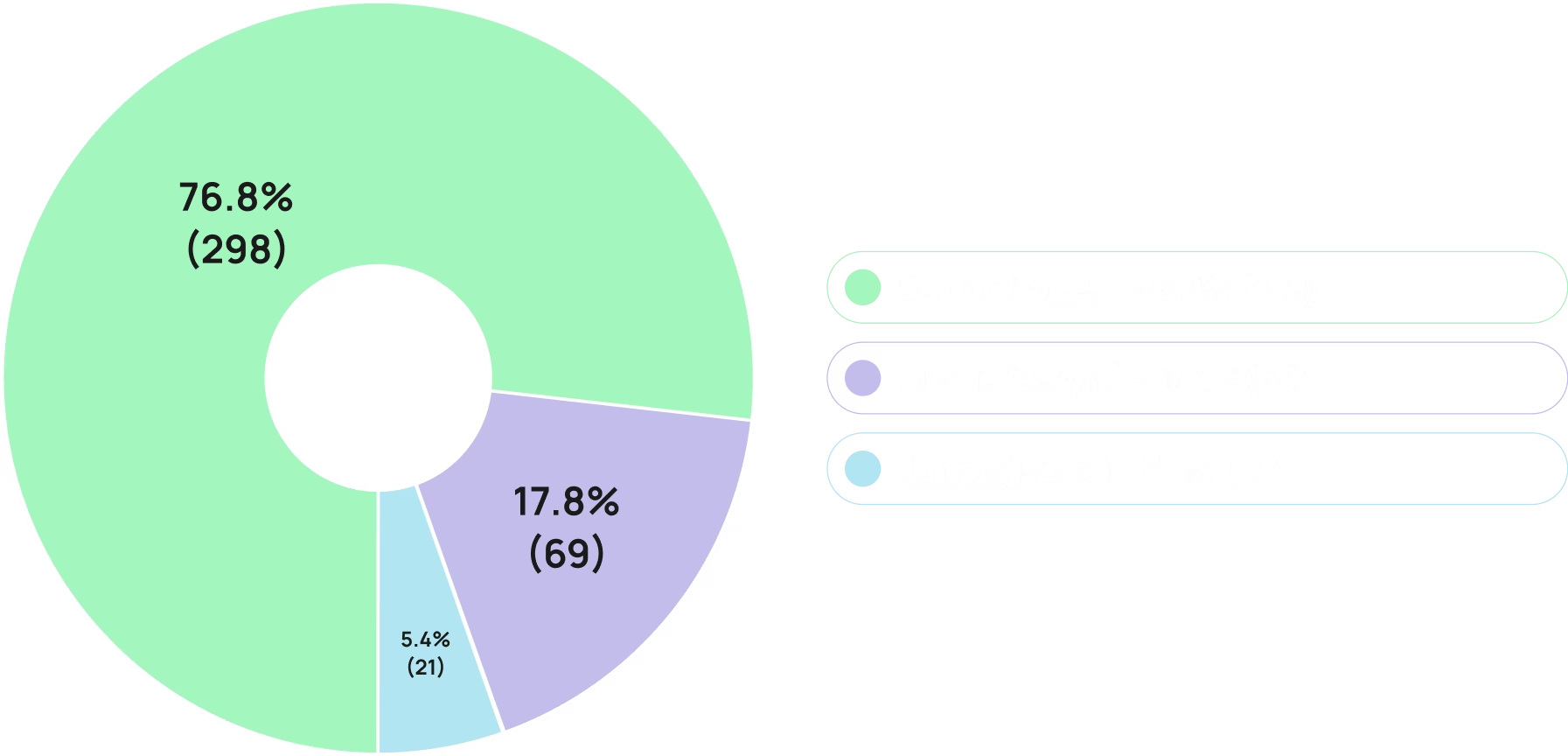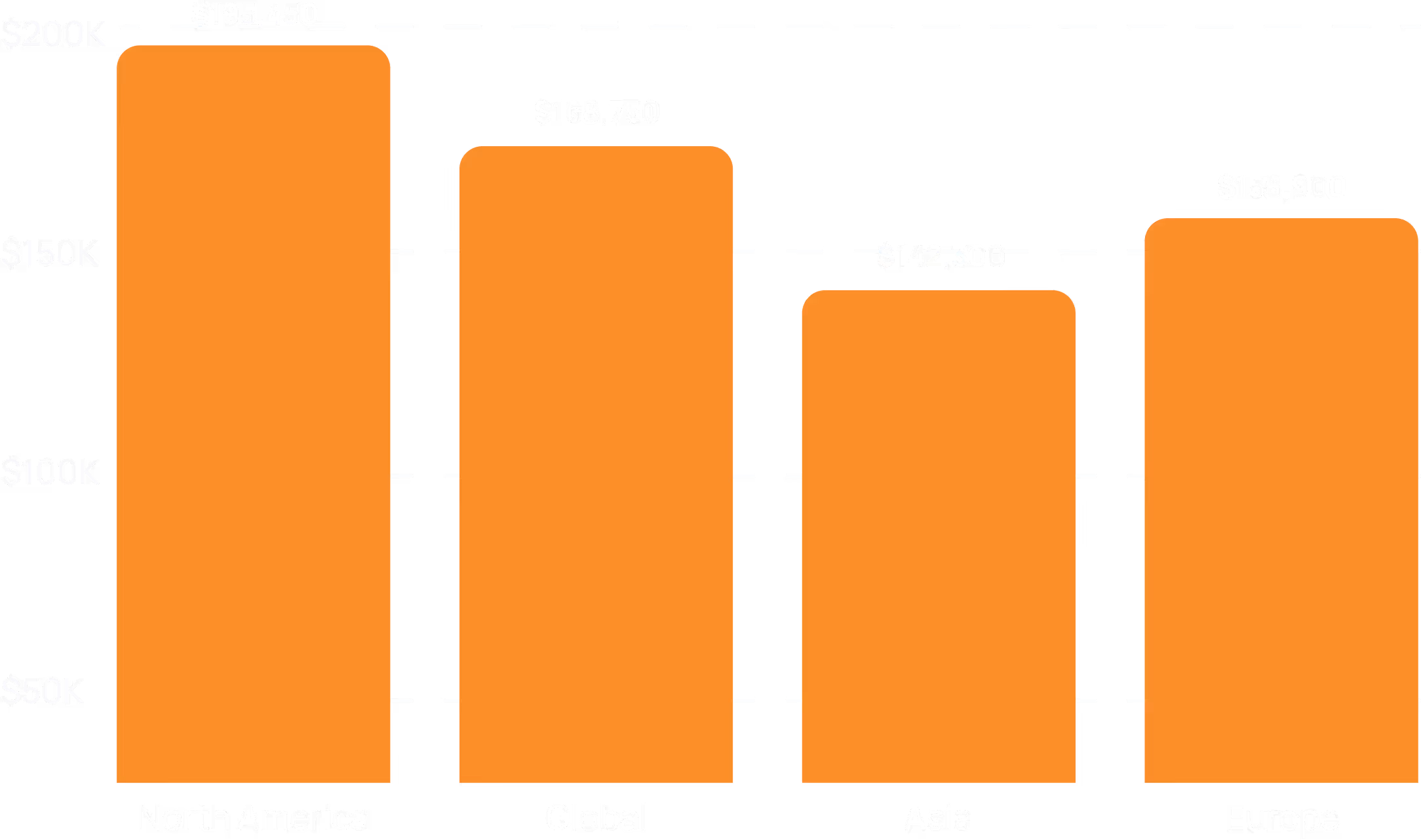
Exec Summary
In the first half of 2025 we witnessed significant changes across Web3 employment, marked by stabilising growth patterns and strategic shifts in talent allocation across the industry. This report offers a comprehensive analysis of salary trends, work arrangements, seniority distribution, and geographical diversification of Web3 roles during this pivotal period.
Our analysis of 400+ roles reveals several noteworthy developments: remote work retains a strong lead vs hybrid and in-office (73.8% of positions), there’s a continued prioritisation of senior talent (76.8% of roles), and substantial North American growth in market share (up 6.3% to 47.6% of all positions). Salary trends demonstrate particularly robust increases for specialised technical roles, with Smart Contract Developers seeing a 7.4% increase in salary and Research positions experiencing a 10.2% surge - the largest growth across all categories.
The insights presented in this report provide critical intelligence for job seekers planning their career, employers forming competitive compensation strategies, and industry leaders tracking talent market dynamics.
As we navigate the increasingly mature Web3 ecosystem of 2025, understanding these emerging patterns becomes essential for successful talent acquisition and retention in this competitive landscape.
Web3 Salary & Hiring Quick Trends Catchup
Remote roles represent 73.8% (286) of positions, with hybrid at 14.8% (57) and in-office at 11.4% (44).
H1 2025 shows 73.8% of positions offering fully remote arrangements. This represents a slight decrease from 76.5% in H2 2024, while hybrid roles decreased slightly by 1.3% (from 16.1%). In-office positions increased to 11.4% in H1 2025, up from 7.3% in H2 2024.
While remote work still dominates at 73.8%, the 4.1% increase in in-office roles points to some organisations seeking greater in-person collaboration, likely in response to operational, cultural, or productivity goals. This trend indicates a gradual rebalancing of work models in the maturing Web3 space.
Senior roles dominate at 76.8% (298), with mid-level at 17.8% (69) and junior positions at only 5.4% (21).
Senior positions increased by 13.0% from H2 2024 (63.8%), while mid-level roles decreased by 16.1% (from 33.9%). Junior positions increased by 1.9% (from 3.5%), highlighting an intensifying preference for seasoned professionals, though with a slight uptick in entry-level opportunities.
The sharp rise in senior roles reflects the continued maturation of Web3 projects, where organisations prioritise highly experienced professionals to manage growing technical and regulatory complexity. The decline in mid-level roles may suggest a contracting middle layer, potentially limiting internal growth paths. However, the modest increase in junior roles could hint at early-stage efforts to revive the talent pipeline, though these remain minimal.
North America leads with 47.6% (183) of roles, followed by Europe 27.8% (107), Global 13.2% (51), and Asia 11.5% (44).
North America's share increased 14.9% from H2 2024 (32.7%), reflecting its growing dominance in the market. Europe experienced a notable 6.4% decline (from 34.2%), while globally remote positions dropped by 8.7% (from 21.9%). Asia saw a modest 0.3% increase (from 11.2%), indicating relative stability in the region.
The sharp rise in North American roles signals a strong rebound in regional hiring, likely fueled by improved regulatory clarity and renewed investor confidence. Europe's significant decline suggests mounting pressure from shifting global dynamics, including tighter regulations or talent migration. Meanwhile, the substantial drop in globally remote roles may reflect a narrowing of location-agnostic hiring in favor of region-specific strategies. Asia’s stability indicates sustained but cautious growth in the region.
Analysis shows significant salary disparities between technical and non-technical roles, with top developer positions commanding premium compensation packages.
In H1 2025, Smart Contract Developer salaries increased by 7.4% to an average of $185,000 (from 172,297), while Frontend Developer salaries saw 8.1% increase $135,940 in H2 2024 to 147,000. Research and DevRel roles experienced the most significant salary growth at 10.2% and 9.5% respectively, reflecting increased demand for ecosystem development and technical education.
The accelerating premiums for technical & specialised roles, particularly in smart contract development and research, indicate a maturing industry focusing on security, scalability, and sustainable infrastructure. Organisations are increasingly willing to pay top dollar for specialised expertise that can both innovate and safeguard digital assets, while also investing in ecosystem growth through research and developer relations.
Average Salary by Job Category

Mastery of Solidity and Rust programming languages is essential, with growing demand for expertise in zero-knowledge proofs, formal verification, and cross-chain protocol development. Experience with security auditing tools, gas optimisation techniques, and advanced cryptographic implementations has become increasingly valuable in H1 2025.
The average salary for smart contract developers in H1 2025 is $185,000, with a range up to $350K. The middle 50% earn between $155K and $215K, showing a concentration of well-compensated senior roles in this category.
An average salary of $170,000. The salary range spanned from $70K to $350K, with the majority falling between $127.5K and $200K.
Familiarity with Web3-specific UX patterns, Figma prototyping for blockchain applications, and token-based incentive design have become key differentiators. Experience in designing permissionless systems, visualising complex DeFi mechanics, and creating accessible interfaces for mainstream adoption is highly valued.
H1 2025 salaries average $158,750, with a range up to $315K. The middle 50% earn between $120K and $175K.
The average salary increased by 6.4% from $149,200 in H2 2024. The upper salary limit rose to $315K, while the entry-level threshold increased from $36K to $45K, showing growing recognition of design's strategic importance in Web3 product success.
Advanced capabilities in data analysis, economic modeling, and protocol design are essential. Growing emphasis on cross-chain analysis, tokenomics simulation, formal verification methods, and security vulnerability research. Experience with academic publication, technical writing, and communicating complex concepts to diverse audiences is increasingly valued.
H1 2025 research roles average $168,000, with a range up to $330K. The middle 50% earn between $125K and $190K.
The average salary increased by 10.2% from $152,500 in H2 2024. The salary ceiling has risen from $300K to $330K, while the entry-level floor increased from $60K to $75K, reflecting the strategic importance of research in driving Web3 innovation.
Leadership experience in Web3-native organisations with distributed teams is highly prized. Expertise in managing technical talent, navigating regulatory uncertainty, and balancing decentralised governance with operational efficiency has become essential. Experience with treasury management, organisational design for DAOs, and cross-cultural remote team leadership is increasingly valuable.
H1 2025 management salaries average $172,000, with a range up to $340K. The middle 50% earn between $120K and $210K.
The average salary increased by 7.8% from $159,500 in H2 2024. The upper range expanded to $340K from $325K, while the entry-level floor increased from $70K to $85K, reflecting the growing complexity of leadership roles in the maturing Web3 sector.
Strong expertise in React, TypeScript, and state management libraries remains essential, with increasing demand for skills in Web3 wallet integration, NFT rendering, and real-time transaction interfaces. Experience with wallet connection standards, internationalisation, and progressive web app development for dApp interfaces has become more valuable.
H1 2025 salaries average $147,000, with a range up to $285K. The middle 50% earn between $95K and $185K.
The average salary increased by 8.1% from $135,940 in H2 2024. While the entry-level floor has risen from $50K, the upper range has also expanded from $275K to $285K, reflecting the growing importance of sophisticated user interfaces in Web3 applications.
Expertise in enterprise blockchain sales, institutional client management, and navigating complex compliance requirements is highly valued. Experience selling to DAOs, protocols, and traditional finance entities looking to enter Web3 is increasingly important. Growing emphasis on consultative selling approaches that can educate potential clients on technical solutions.
H1 2025 sales roles average $110,250, with a range up to $190K. The middle 50% earn between $85K and $145K.
The average salary increased by 9.8% from $100,500 in H2 2024. Both the lower and upper bounds of the salary range have increased, with the ceiling rising from $175K to $190K and the floor increasing from $25K to $35K, reflecting growing professionalisation of sales functions in Web3 organisations.
Strong technical understanding of blockchain protocols combined with exceptional communication and community-building skills are essential. Experience creating developer documentation, tutorial content, and code samples that bridge complex technical concepts with practical implementation is highly valued. Growing emphasis on video creation, workshop facilitation, and managing developer communities across multiple platforms.
H1 2025 salaries average $137,500, with a range up to $230K. The middle 50% earn between $90K and 165K.
The average salary increased by 9.5% from $125,500 in H2 2024. The upper salary limit rose to $230K, while the entry-level threshold increased from $55K to $65K, reflecting growing recognition of developer relations as a critical function for protocol adoption and ecosystem growth.
Deep understanding of crypto-native communities, social platforms, and content distribution channels is essential. Experience with token-incentivised growth strategies, community activation campaigns, and narrative development for technical protocols is highly valued. Growing emphasis on data-driven marketing, multi-channel campaign management, and crisis communications in volatile market conditions.
H1 2025 marketing salaries average $152,750, with a range up to $265K. The middle 50% earn between $105K and $185K.
The average salary increased by 7.2% from $142,500 in H2 2024. The upper salary limit rose from $250K to $265K, while the entry-level threshold increased from $75K to $80K, reflecting the strategic importance of sophisticated marketing in an increasingly competitive landscape.
Proficiency in Rust continues to command a premium, with Python, Go, and TypeScript also in high demand. Expertise in distributed systems, high-throughput databases, and scalability solutions for L1/L2 blockchains has become increasingly valuable. Knowledge of RPC node operation, indexing services, and secure API design are also sought after.
H1 2025 salaries average $163,500, ranging up to $290K. The middle 50% earn between $110K and $205K, showing increased stratification between junior and senior roles.
The average salary increased by 11.1% from $147,177 in H2 2024. The salary ceiling has increased from $275K to $290K, while the entry-level floor has risen from $30K to $45K, indicating growing recognition of this role's importance across all experience levels.
Highest Salaries Across Web3 Roles
Lowest Salaries Across Web3 Roles
Workplace Preference in Web3


Remote work continues to dominate the Web3 landscape in H1 2025, with 73.8% (286) of positions offering fully remote arrangements commanding an average salary of $165,202. This represents a slight decrease from 76.5% in H2 2024, suggesting a subtle shift in workplace preferences while maintaining remote work as the standard.
The persistent dominance of remote roles reflects Web3's commitment to borderless talent acquisition and distributed team structures. However, the minor decline indicates growing interest in alternative arrangements that balance flexibility with in-person collaboration benefits
In-office positions have increased to 11.4% (44) in H1 2025 commanding an average salary of $190,808, up from 7.3% in H2 2024. This 56% proportional increase represents the most significant shift in workplace arrangements, suggesting a growing desire among web3 organisations for co-located teams.
The notable rise in in-office roles signals a potential countertrend in the predominantly remote Web3 landscape. This shift may be driven by companies seeking stronger team cohesion, improved security protocols, or enhanced creative collaboration through physical proximity.
Hybrid arrangements account for 14.8% (57) of roles in H1 2025 commanding an average salary of $167,160, showing a slight decrease from 16.2% in H2 2024. This suggests some organisations are moving toward structured office environments rather than maintaining hybrid models.
While hybrid roles remain an important component of the Web3 workplace ecosystem, their slight decline may reflect practical challenges in managing distributed teams with partial in-office requirements. Organisations appear to be refining their approach based on team productivity and collaboration needs.
Strategic Implications for Talent and Organisations
For recruiters and professionals navigating the Web3 job market in 2025, these trends highlight the importance of flexibility and adaptation. While remote work remains the standard, the increasing diversity in workplace arrangements suggests Web3 organisations are evolving beyond one-size-fits-all approaches to optimise for team performance and organisational needs.
Seniority Breakdown in the Web3 Sector

The Web3 sector shows continued and increasing reliance on senior professionals, with 76.8% (298) of positions classified as senior-level in H1 2025, up significantly from 63.8% in H2 2024. This substantial increase of 13 percentage points highlights the industry's growing demand for experienced leaders who can navigate the evolving Web3 landscape.
The significant rise in senior roles reflects the maturing Web3 industry's focus on experienced talent capable of solving complex technical challenges and leading strategic initiatives. Organisations are prioritising proven expertise over potential, particularly for roles requiring deep domain knowledge in security, scalability, and protocol design.
Mid-level positions decreased to 17.8% (69) in H1 2025, down significantly from 33.9% in H2 2024. This sharp reduction suggests a substantial shift in hiring priorities away from developing talent toward securing established expertise.
The decline in mid-level roles creates potential career progression challenges within the ecosystem. While offering fewer opportunities for mid-career professionals, this trend also presents a competitive advantage for those who do secure these positions, as they become prime candidates for future senior roles in an environment with limited mid-level talent development.
Junior positions increased moderately to 5.4% (21) in H1 2025, up from 3.5% in H2 2024. While still representing a small minority of overall positions, this 54% proportional increase signals increased attention to entry-level talent pipeline development.
The growth in junior roles, while modest, represents a positive signal for ecosystem sustainability. This trend suggests some organisations are beginning to invest in talent development to address the severe senior talent shortage, though the overall proportion remains concerningly low for long-term industry health.
Strategic Implications for Talent and Organisations
The very high concentration of senior roles (76.8%) coupled with limited mid-level (17.8%) and junior positions (5.4%) creates significant strategic challenges for the Web3 ecosystem. This top-heavy distribution reflects immediate needs for experienced talent but raises serious concerns about sustainable talent pipeline development. Organisations should consider implementing structured mentorship programs and creating more junior opportunities to ensure long-term ecosystem growth and talent retention.
Job Distribution by Region

Roles open to Asia-based professionals increased slightly to 11.5% (44) in H1 2025, up marginally from 11.2% in H2 2024. This relative stability suggests that Asia maintains its position as an important, if secondary, region for Web3 talent.
Asia's consistent representation in the Web3 job market reflects the region's established role in cryptocurrency adoption and blockchain development. The stability may indicate that regional hiring strategies have reached an equilibrium point after previous fluctuations.
In H1 2025, 27.8% (107) of Web3 roles were based in or accessible to professionals in Europe, a notable decrease from 34.2% in H2 2024. This 6.4 percentage point decline represents the most significant regional shift in job distribution, suggesting changing priorities in geographical talent sourcing.
Despite the decrease, Europe remains an important hub for Web3 talent with more than a quarter of all positions. The reduction may reflect increased competition from other regions rather than diminished European importance in the ecosystem.
Globally accessible roles decreased significantly to 13.2% (51) in H1 2025, down from 21.9% in H2 2024. This 8.7 percentage point reduction suggests a potential shift away from geography-agnostic hiring toward more regionally focused talent acquisition strategies.
The sharp decline in globally accessible roles represents a concerning trend for talent in regions outside major Web3 hubs. This shift may reflect organisations' increasing preference for team members in similar time zones or regions to facilitate better collaboration and regulatory compliance.
Jobs based in North America increased dramatically to 47.6% (183) in H1 2025, up from 32.7% in H2 2024. This 14.9 percentage point surge reinforces North America's dominance as the primary center for Web3 employment opportunities.
North America's substantial growth likely reflects improved regulatory clarity in the US market combined with robust venture capital funding recovery. Companies appear to be consolidating technical and leadership roles in North American hubs, potentially in response to changing market conditions and talent availability.
Strategic Implications for Talent and Organisations
North America's dominance (47.6%) coupled with Europe's continued significance (27.8%) creates a pronounced Western concentration of Web3 opportunities. For professionals, this trend emphasises the strategic advantage of positioning within these primary markets, while organisations should recognise the potential innovation limitations of such concentrated talent pools. Reduced global roles (13.2%) restrict access to diverse perspectives and may exacerbate talent shortages, suggesting a need for more inclusive hiring strategies.
Average Salary by locations

North America continues to offer the highest average compensation in the Web3 sector at $195,450 for H1 2025, up 7.3% from $182,150 in H2 2024. This significant increase solidifies North America's position as the premium market for Web3 talent.
North America's salary premium reflects both the higher cost of living in major tech hubs and intense competition for specialised blockchain talent. The substantial year-over-year increase suggests growing demand outpacing supply, particularly for experienced engineers and protocol specialists with regulatory expertise.
Globally distributed roles now average $168,750 in H1 2025, up 5.1% from $160,500 in H2 2024. These positions continue to occupy a middle ground between North American and European compensation levels.
The premium over European salaries (by $9,850) but discount to North American compensation (by $26,700) suggests global roles use a blended approach to salary determination. As remote work becomes increasingly standardised, this category shows signs of maturing into a distinct compensation band rather than simply splitting regional differences.
Asia shows the most dramatic salary growth, with average compensation reaching $142,300 in H1 2025, a substantial 11.2% increase from $128,000 in H2 2024. This acceleration represents the fastest regional growth rate in the Web3 ecosystem.
Asia's remarkable salary growth signals the region's increasing importance in the global Web3 landscape, with particular strength in trading, gaming, and DeFi applications. This trend appears driven by significant investment in Singapore, Hong Kong, and South Korea as regulatory frameworks mature.
European salaries have increased to an average of $158,900 in H1 2025, up 4.8% from $151,600 in H2 2024. While this growth is positive, the widening gap with North America (now at $36,550) represents a concerning trend for European talent retention.
Europe's more moderate salary growth compared to North America reflects regional variations in funding environments and market maturity. European Web3 companies increasingly compete on factors beyond compensation, including work-life balance, project innovation, and regulatory stability.
Strategic Implications for Talent and Organisations
The rising salary trend across all regions (North America: +7.3%, Europe: +4.8%, Asia: +11.2%, Global: +5.1%) indicates continued strong demand for Web3 talent despite market volatility. The gap between regions, however, may drive further talent migration toward higher-paying markets, potentially exacerbating regional expertise imbalances. Organisations should consider these widening differentials when crafting compensation strategies, particularly for roles requiring specialised technical or regulatory knowledge where talent mobility is highest.

Summary
During H1 2025, there was a continued preference for remote work (73.8%) alongside an increasing desire for in-office arrangements, with senior roles (76.8%) still dominating the talent landscape. North America led the job distribution (47.6%), and maintained the highest average salaries ($190,417).
For job seekers, focusing on technical skills in smart contract development, security, and backend engineering offers the strongest positioning, particularly in the DeFi and infrastructure sectors. Employers should consider flexible work arrangements and competitive compensation packages to attract and retain top talent.
Looking ahead to H2 2025, we anticipate continued stabilisation in salary levels, further geographic diversification of talent, and growing demand for specialised skills in emerging areas like zkML, MPC, and AI-blockchain integration based on current trajectory and market signals.
This report was compiled based on proprietary industry data collected in Q1 2025. For inquiries regarding methodology or detailed findings, please contact the team at info@calyptus.co.
Get your free report
Share your details and get last quarter's breakdown from average tech salaries to workplace preferences in Web3.






